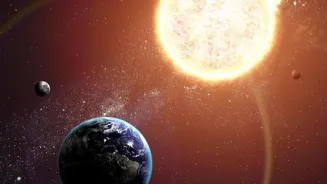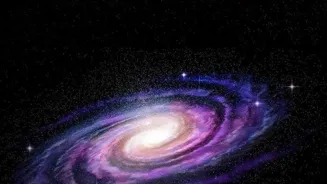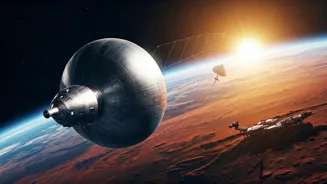Delve into the fascinating world of solar system formation: unraveling mysteries of our cosmic neighborhood
In a cosmic dance billions of years in the making, our solar system emerged from a swirling cloud
of gas and dust. Scientists have been piecing together this puzzle for centuries, and recent discoveries are shedding new light on the processes that birthed our planetary neighborhood.
From the initial collapse of a molecular cloud to the formation of planets and asteroids, understanding our solar system's origin helps us understand how common such systems might be throughout the galaxy. It also gives crucial insights into the conditions that are necessary for life to arise.
Formation of our solar system via Nebular Hypothesis
The most widely accepted theory for the formation of our solar system is the Nebular Hypothesis. It proposes that around 4.6 billion years ago, a giant molecular cloud, a vast region of space filled with gas and dust, began to collapse under its own gravity.
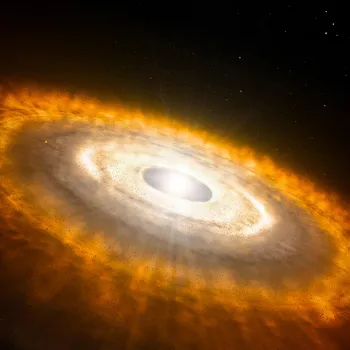
This collapse may have been triggered by a nearby supernova explosion, which would have sent shockwaves rippling through the cloud. As the cloud collapsed, it began to spin faster and faster, much like a figure skater pulling their arms in.
This spinning motion caused the cloud to flatten into a rotating disk called a protoplanetary disk. At the center of this disk, the majority of the mass collected, forming a protostar, the early stage of our Sun.
The remaining material in the disk then began to clump together, eventually forming the planets, asteroids, and comets that make up our solar system today.
Accretion process forms rocky inner planets in solar system
One of the key processes in planet formation is accretion. This is where small dust grains collide and stick together, gradually growing larger and larger over time. Initially, these dust grains are held together by electrostatic forces.
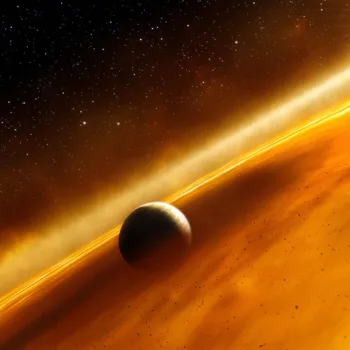
As they grow larger, gravity begins to play a more significant role. These growing clumps, called planetesimals, continue to collide and merge, eventually forming protoplanets, which are the building blocks of planets.
The inner solar system, closer to the Sun, was much hotter than the outer solar system. This meant that only materials with high melting points, such as rock and metal, could condense and form solid bodies.
This is why the inner planets – Mercury, Venus, Earth, and Mars – are rocky and relatively small.
Outer solar system's icy materials allowed gas giants to form, possibly migrating later
The outer solar system, being further from the Sun, was cold enough for volatile substances like water, ammonia, and methane to freeze into ice. These icy materials were much more abundant than rock and metal, allowing the outer planets – Jupiter, Saturn, Uranus, and Neptune – to grow much larger.
These giant planets also had enough gravity to attract and hold onto the surrounding gas, primarily hydrogen and helium, making them gas giants. However, the story of planet formation is not always straightforward.
Some theories suggest that the giant planets may have migrated from their original orbits, interacting gravitationally with other planets and scattering them in the process.
Space missions reveal insights on solar system formation
Recent discoveries from space missions are helping to refine our understanding of solar system formation. For example, the Rosetta mission to comet 67P/Churyumov-Gerasimenko provided valuable insights into the composition of comets, which are believed to be remnants of the early solar system.

The data collected by Rosetta showed that comets contain organic molecules, the building blocks of life, further supporting the idea that comets may have played a role in delivering water and organic materials to Earth.
Similarly, the Dawn mission to the asteroid Vesta and the dwarf planet Ceres provided detailed information about the composition and structure of these objects, offering clues about the conditions in the early solar system.
Meteorites yield crucial insights into solar system formation
The study of meteorites also provides valuable information about the formation of our solar system. Meteorites are fragments of asteroids or comets that have fallen to Earth.
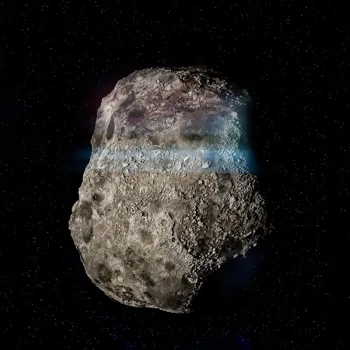
By analyzing the chemical composition and isotopic ratios of meteorites, scientists can learn about the materials that made up the early solar system and the processes that occurred during its formation.
Some meteorites contain chondrules, small, spherical grains that are believed to be among the first solid objects to form in the protoplanetary disk.
By studying chondrules, scientists can gain insights into the conditions in the early solar system and the processes that led to the formation of planets.
Future missions and research will undoubtedly continue to unravel the mysteries of our solar system's origin, giving us a deeper understanding of our place in the cosmos.
AI Generated Content. Glance/InMobi shall have no liability for the content